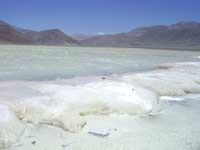The living beings of the past, alive in the Andes
Stromatolites were photosynthetic microorganisms that appeared in shallow seas, forming organic rocks associated with calcareous concentrations. For millions of years they predominated throughout the planet.
Now, some researchers have found live stromatolites in some salt lakes of the Andes at more than 4,000 meters of altitude. Although fossil stromatolites are found in different parts of the world, it is very difficult to find live stromatolites. There are some at sea, such as in the Australian Shark Bay, or in salty lakes, such as in Yellowston, but it is the first time they find them at such high altitude.

Argentine researchers have found live stromatolites in some salt lakes of the Andes. (Photo: María Eugenia FarÃas)
The discovery was made by researchers from the Laboratory of Microbiological Research of the Lakes of the Andes LIMLA, directed by the microbiologist MarÃa Eugenia FarÃas. The lakes are located in the Argentine province of Salta, in the highlands of Puna, with very salty waters. FarÃas has explained that at this height the ultraviolet radiation is very large and the oxygen voltage is low. In his opinion, "there are conditions similar to those of a time when the Earth was young."
After the study of these stromatolites, the researchers hope to obtain data to know better the evolution of the Earth. In fact, scientists believe that the composition of the atmosphere changed thanks to stromatolites. During photosynthesis, photosynthetic organisms capture carbon dioxide and release oxygen. This is what the stromatolites did, so the oxygen concentration in the atmosphere was increasing progressively. This allowed to create organisms that breathe oxygen. Therefore, the stromatolites had great importance in the history of the Earth.
Future and distant
In addition to knowing the past, the stromatolites of the lakes of Puna are valuable for future research. According to FarÃas, its characteristics are very special and based on them can develop interesting biotechnological applications. For example, its ability to fix carbon dioxide in extreme conditions can be useful to create an application against climate change. Other applications can be ultraviolet radiation filters, antioxidant substances, nitrogen fixation systems in the soil, bioremediation.
They also serve to investigate what kind of living beings have existed or may exist on other planets. This field of science is called astrobiology, so the NASA Department of Astrobiology has invited LIMLA to collaborate.
However, all these investigations cannot be carried out if the stromatolites disappear. And if there is danger: A well near the town of Tolar Grande is already contaminated, probably with black waters that reach the village and whose stromatoliths are dead. The water of Lake Socompa is directed to Chile for mining.
"There are laws to protect the flora, fauna and archaeological heritage, but if someone takes a piece of stromatolite here, or a piece of ice in Perito Moreno, or sediments from the channel of Beagle, he should know that he is taking a genetic material as important as plants and animals," said FarÃas.
For this reason, researchers have asked the authorities to implement laws to protect the lakes and to carry out the necessary infrastructures. In short, the researchers are convinced that the investments made there will be beneficial to revitalize the economy of the environment. We, from here, will continue to pay attention to the research carried out there, if they answer the past, the future or some question about aliens.
Published in Gara
Buletina
Bidali zure helbide elektronikoa eta jaso asteroko buletina zure sarrera-ontzian











